check transmission fluid FORD F250 1998 Owners Manual
[x] Cancel search | Manufacturer: FORD, Model Year: 1998, Model line: F250, Model: FORD F250 1998Pages: 219, PDF Size: 1.65 MB
Page 106 of 219
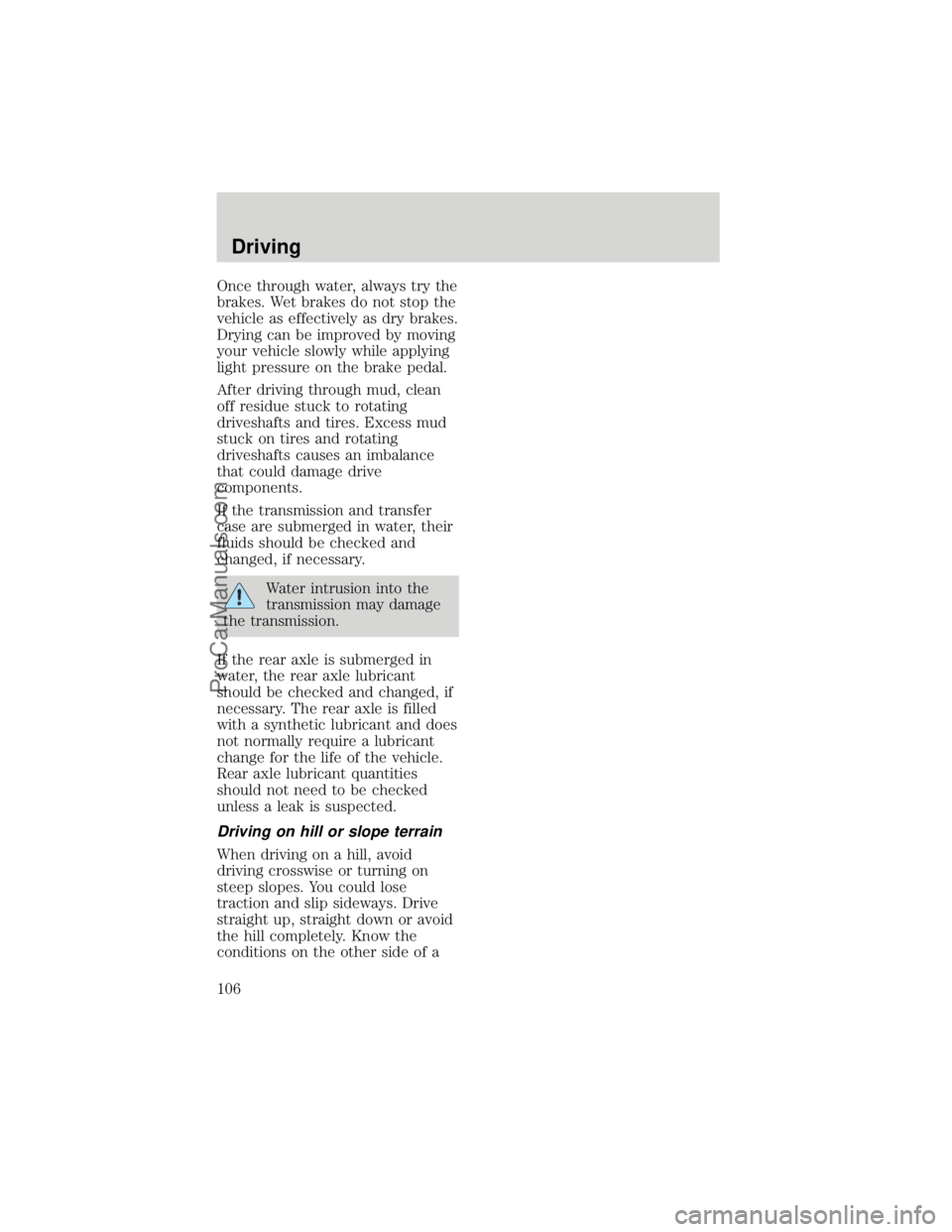
Once through water, always try the
brakes. Wet brakes do not stop the
vehicle as effectively as dry brakes.
Drying can be improved by moving
your vehicle slowly while applying
light pressure on the brake pedal.
After driving through mud, clean
off residue stuck to rotating
driveshafts and tires. Excess mud
stuck on tires and rotating
driveshafts causes an imbalance
that could damage drive
components.
If the transmission and transfer
case are submerged in water, their
fluids should be checked and
changed, if necessary.
Water intrusion into the
transmission may damage
the transmission.
If the rear axle is submerged in
water, the rear axle lubricant
should be checked and changed, if
necessary. The rear axle is filled
with a synthetic lubricant and does
not normally require a lubricant
change for the life of the vehicle.
Rear axle lubricant quantities
should not need to be checked
unless a leak is suspected.
Driving on hill or slope terrain
When driving on a hill, avoid
driving crosswise or turning on
steep slopes. You could lose
traction and slip sideways. Drive
straight up, straight down or avoid
the hill completely. Know the
conditions on the other side of a
Driving
106
ProCarManuals.com
Page 156 of 219
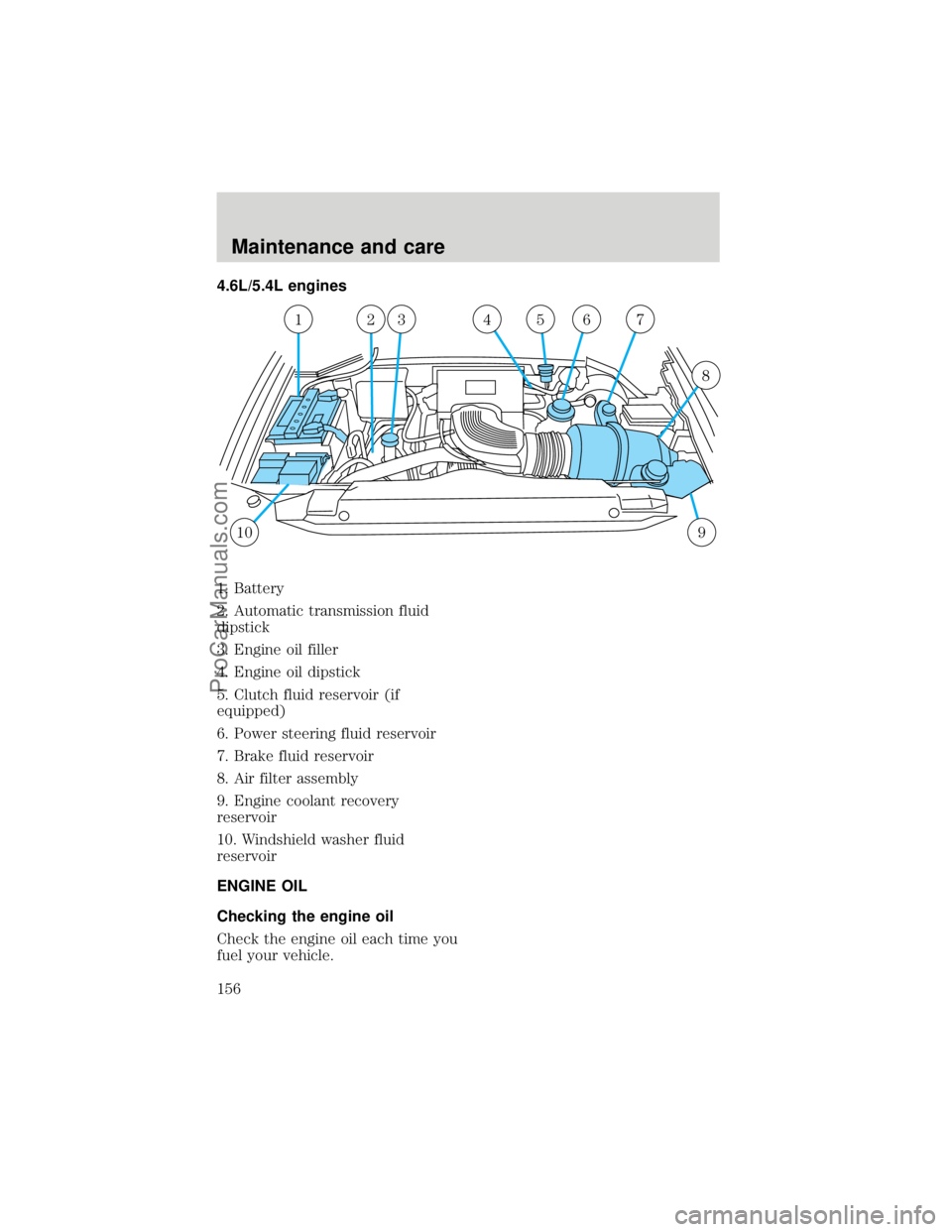
4.6L/5.4L engines
1. Battery
2. Automatic transmission fluid
dipstick
3. Engine oil filler
4. Engine oil dipstick
5. Clutch fluid reservoir (if
equipped)
6. Power steering fluid reservoir
7. Brake fluid reservoir
8. Air filter assembly
9. Engine coolant recovery
reservoir
10. Windshield washer fluid
reservoir
ENGINE OIL
Checking the engine oil
Check the engine oil each time you
fuel your vehicle.
109
1234657
8
Maintenance and care
156
ProCarManuals.com
Page 170 of 219
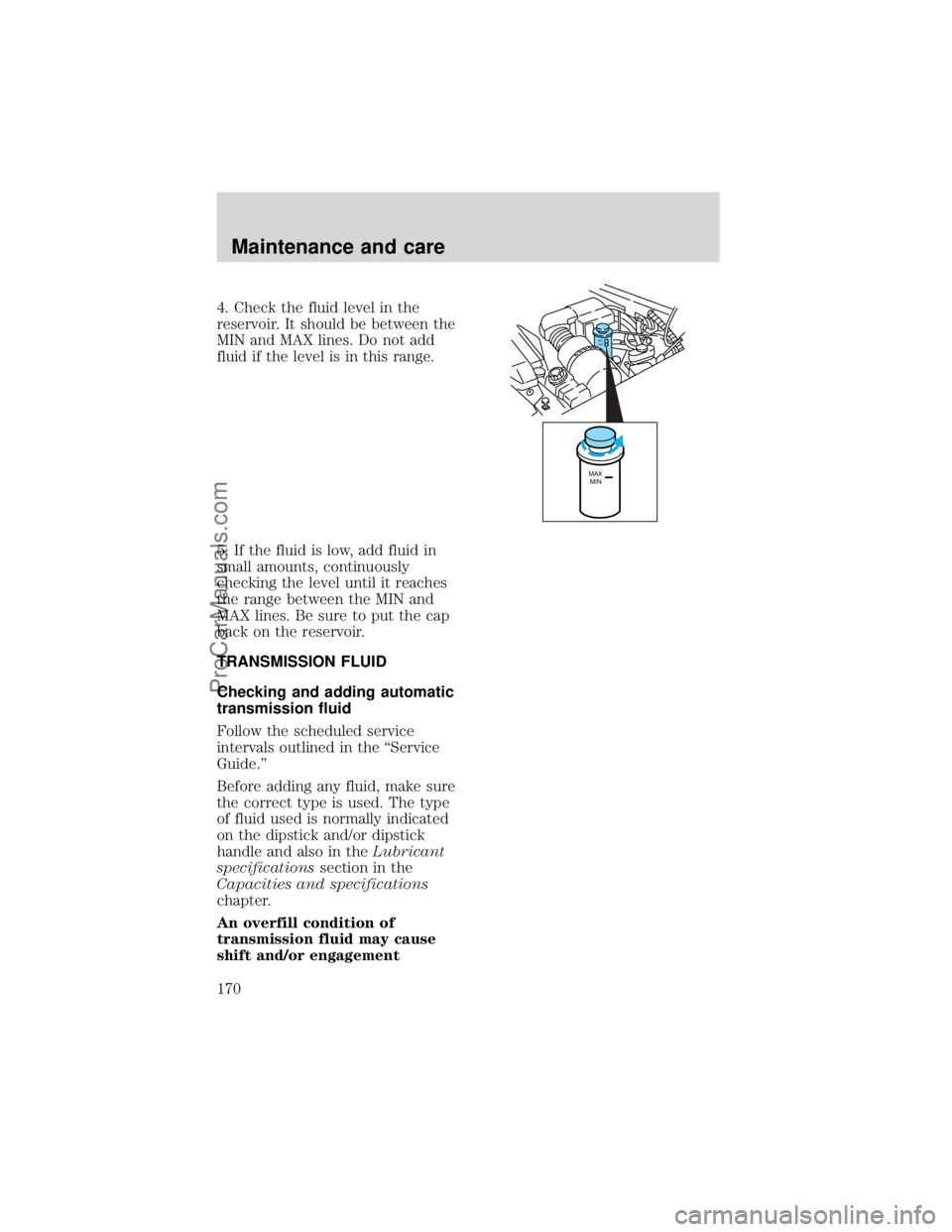
4. Check the fluid level in the
reservoir. It should be between the
MIN and MAX lines. Do not add
fluid if the level is in this range.
5. If the fluid is low, add fluid in
small amounts, continuously
checking the level until it reaches
the range between the MIN and
MAX lines. Be sure to put the cap
back on the reservoir.
TRANSMISSION FLUID
Checking and adding automatic
transmission fluid
Follow the scheduled service
intervals outlined in the ªService
Guide.º
Before adding any fluid, make sure
the correct type is used. The type
of fluid used is normally indicated
on the dipstick and/or dipstick
handle and also in theLubricant
specificationssection in the
Capacities and specifications
chapter.
An overfill condition of
transmission fluid may cause
shift and/or engagement
MAX
MIN
MAX
MIN
Maintenance and care
170
ProCarManuals.com
Page 171 of 219
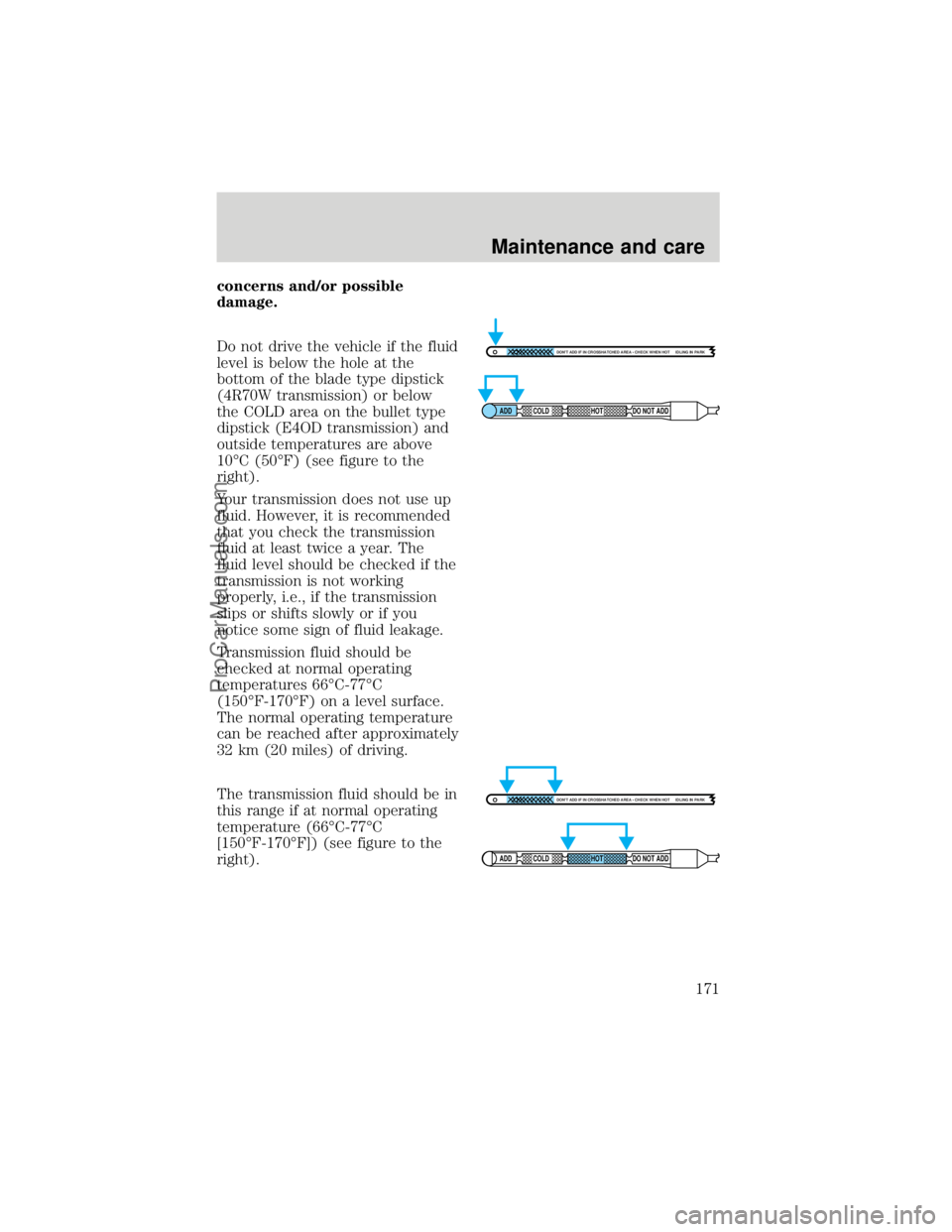
concerns and/or possible
damage.
Do not drive the vehicle if the fluid
level is below the hole at the
bottom of the blade type dipstick
(4R70W transmission) or below
the COLD area on the bullet type
dipstick (E4OD transmission) and
outside temperatures are above
10ÉC (50ÉF) (see figure to the
right).
Your transmission does not use up
fluid. However, it is recommended
that you check the transmission
fluid at least twice a year. The
fluid level should be checked if the
transmission is not working
properly, i.e., if the transmission
slips or shifts slowly or if you
notice some sign of fluid leakage.
Transmission fluid should be
checked at normal operating
temperatures 66ÉC-77ÉC
(150ÉF-170ÉF) on a level surface.
The normal operating temperature
can be reached after approximately
32 km (20 miles) of driving.
The transmission fluid should be in
this range if at normal operating
temperature (66ÉC-77ÉC
[150ÉF-170ÉF]) (see figure to the
right).
DON'T ADD IF IN CROSSHATCHED AREA • CHECK WHEN HOT IDLING IN PARK
ADD COLD HOT DO NOT ADD
DON'T ADD IF IN CROSSHATCHED AREA • CHECK WHEN HOT IDLING IN PARK
ADD COLD HOT DO NOT ADD
Maintenance and care
171
ProCarManuals.com
Page 172 of 219
![FORD F250 1998 Owners Manual The transmission fluid should be in
this range if at room temperature
(10ÉC-35ÉC [50ÉF-95ÉF]) (see
figure to the right).
If your vehicle has been operated
for an extended period at high
speeds, in FORD F250 1998 Owners Manual The transmission fluid should be in
this range if at room temperature
(10ÉC-35ÉC [50ÉF-95ÉF]) (see
figure to the right).
If your vehicle has been operated
for an extended period at high
speeds, in](/img/11/57801/w960_57801-171.png)
The transmission fluid should be in
this range if at room temperature
(10ÉC-35ÉC [50ÉF-95ÉF]) (see
figure to the right).
If your vehicle has been operated
for an extended period at high
speeds, in city traffic during hot
weather or pulling a trailer, the
vehicle should be turned off for
about 30 minutes to allow the fluid
to cool before checking.
1. Park the vehicle on a level
surface and engage the parking
brake.
2. With the parking brake engaged
and your foot on the brake pedal,
start the engine and move the
gearshift lever through all of the
gear ranges. Allow sufficient time
for each gear to engage.
3. Latch the gearshift lever in P
(Park) and leave the engine
running.
4. Remove the dipstick, wiping it
clean with a clean, dry lint free
rag.
5. Install the dipstick making sure
it is fully seated in the filler tube.
6. Remove the dipstick and inspect
the fluid level. The fluid level
should be in the crosshatched area
on the dipstick.DON'T ADD IF IN CROSSHATCHED AREA • CHECK WHEN HOT IDLING IN PARK
ADD COLD HOT DO NOT ADD
Maintenance and care
172
ProCarManuals.com
Page 173 of 219
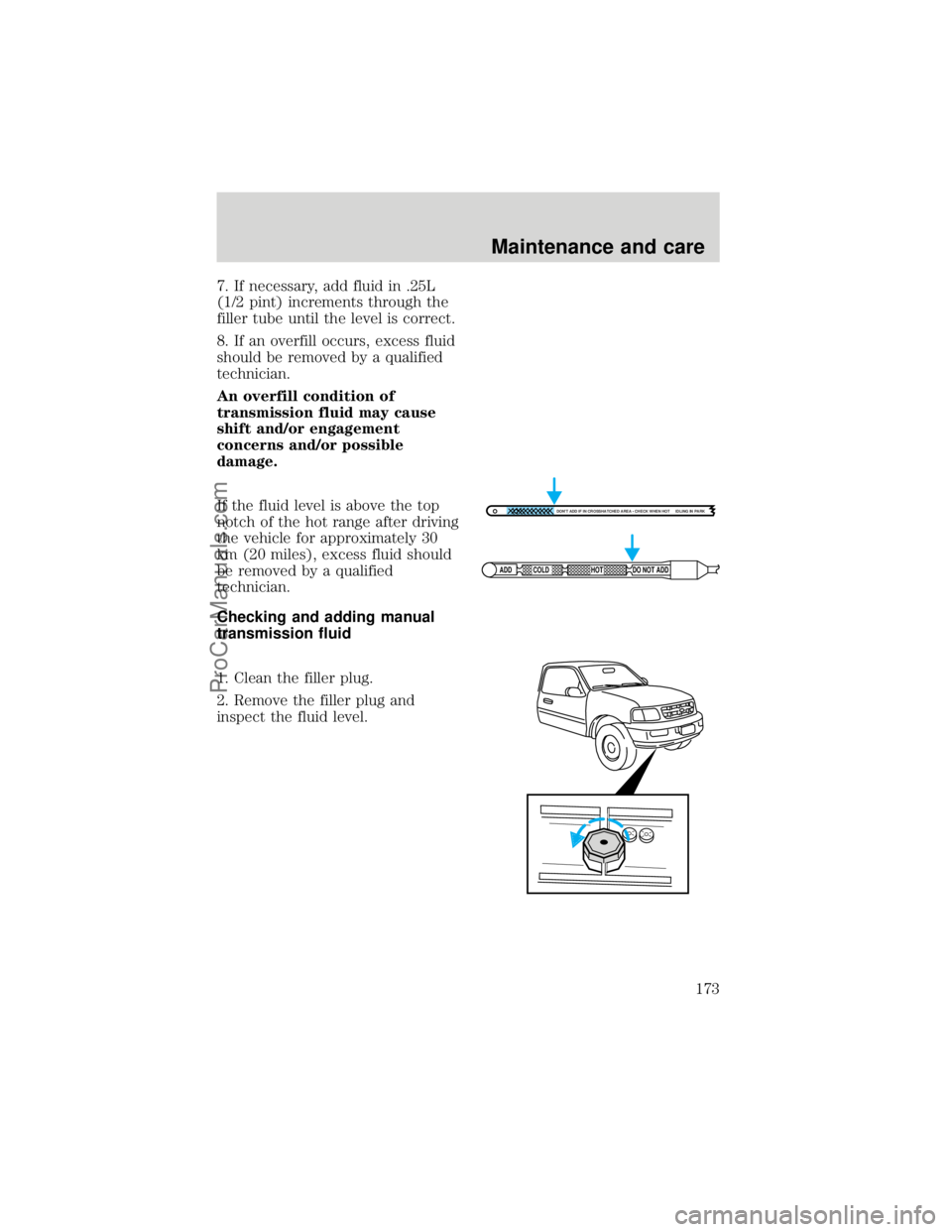
7. If necessary, add fluid in .25L
(1/2 pint) increments through the
filler tube until the level is correct.
8. If an overfill occurs, excess fluid
should be removed by a qualified
technician.
An overfill condition of
transmission fluid may cause
shift and/or engagement
concerns and/or possible
damage.
If the fluid level is above the top
notch of the hot range after driving
the vehicle for approximately 30
km (20 miles), excess fluid should
be removed by a qualified
technician.
Checking and adding manual
transmission fluid
1. Clean the filler plug.
2. Remove the filler plug and
inspect the fluid level.
DON'T ADD IF IN CROSSHATCHED AREA • CHECK WHEN HOT IDLING IN PARK
ADD COLD HOT DO NOT ADD
Maintenance and care
173
ProCarManuals.com
Page 207 of 219

FluidFord Part
NameApplication Capacity
Transmission
fluidMotorcraft
MERCONt
AT F5-speed manual
43.5L (3.75 quarts)
Automatic-E4OD
(4x2)15.0L (15.9 quarts)
Automatic-E4OD
(4x4)15.5L (16.4 quarts)
Motorcraft
MERCONt
VATFAutomatic-4R70W 13.1L (13.9 quarts)
Windshield
washer fluidUltra-Clear
Windshield
ConcentrateAll 4.0L (4.25 quarts)
Your vehicle's rear axle is equipped
with synthetic rear axle lubricant.
Rear axles containing synthetic
lubricant are lubricated for life.
These lubricants do not need to be
checked or changed unless a leak
is suspected, service required or
the axle assembly has been
submerged in water. The axle
lubricant should be changed any
time the rear axle has been
submerged in water.
1Add 118 ml (4 oz.) of additive
friction modifier C8AZ-19B546-A,
Ford specification EST-M2C118±A,
for complete fill of 8.8 inch and
9.75 inch axles.
2Add 236 ml (8 oz.) of additive
Friction Modifier C8AZ-19B546-A,
Ford Specification EST-M2C118-A,
for complete fill of 10.25 inch
axles.
3Fill to bottom of filler hole.
Capacities and specifications
207
ProCarManuals.com
Page 217 of 219

Fuse panels
instrument panel ....................133
power distribution box ...........138
Fuses ...................................132,133
Gauges, Mechanical ....................13
engine coolant temperature
gauge .........................................14
Hazard flashers .........................131
Headlamps
autolamp system .......................18
flashing ......................................35
high beam .................................35
turning on and off ....................17
Heating ........................................20
High beams
indicator light ...........................10
Hood
release lever ............................154
Ignition
positions of the ignition ...........27
removing the key ......................98
Instrument panel
lighting up panel and
interior .......................................18
Jump-starting your
vehicle .................................147,149
attaching cables ......................148
disconnecting cables ..............149
Keyless entry system
autolock .....................................44
Keys
key in ignition chime ...............12
Lamps
interior lamps ...........................36
map lamps .................................36
parking lamps .........................195
Lights, warning and indicator
air bag ..........................................8
anti-lock brakes (ABS) ..............9
anti-theft ...................................10
brake ............................................9
charging system ........................10check engine ............................6,7
door ajar ....................................11
engine oil pressure ...................10
four-wheel drive ........................11
fuel reset ................................6,12
safety belt ...................................9
turn signal indicator ...................9
Load limits
trailer towing ..........................110
Lubricant specifications ....205,208
Manual transmission ...................92
shift speeds .....................94,96,97
Mirrors
side view mirrors (power) .......38
Odometer .....................................15
Off road driving, 4-wheel drive 104
Overdrive ................................35,36
Panic alarm feature, remote
entry system ................................43
Parking brake ..............................85
Parts (see Motorcraft parts) ....205
Power door locks ........................38
Power steering
fluid, checking and adding ....169
Recreational towing, all wheels
on the ground ...........................123
Relays ........................................132
Remote entry system .................42
illuminated entry ......................47
locking/unlocking doors ...........43
replacement/additional
transmitters ...............................46
replacing the batteries .............45
Reporting safety defects ..........215
Safety restraints
automatic locking mode
(retractor) .......................54,55,56
extension assembly ..................57
for children ...............................68
lap and shoulder belts ........53,54
maintenance ..............................58
proper use .................................51
Index
217
ProCarManuals.com
Page 218 of 219

warning light and chime .....12,58
Safety seats for children
attaching with tether straps ....74
automatic locking mode
(retractor) .................................71
tether anchorage hardware .....74
Seats ............................................48
adjusting the seat, manual .......49
adjusting the seat, power ........49
bench (60-40 split) .............48,51
bench seat .................................48
lumbar support .........................50
Servicing your vehicle ..............152
precautions when servicing ...152
Snowplowing ............3,124,125,127
Special notice
utility-type vehicles ....................3
Speed control ..............................28
canceling a set speed ...............31
resuming a set speed ...............32
tap up/tap down .......................30
turning off .................................28
Speedometer ...............................14
Starting your vehicle ........76,77,80
Tachometer
mechanical cluster ...................15
Tailgate ........................................39
removing ...................................40
Tires ....................................179,181
checking the pressure ............181
replacing ..................................183
rotating ....................................182
snow tires and chains ............183
treadwear ................................179
Traction-lok rear axle ..........86,175
Trailer towing .............112,113,114,
115,116,117
tips ...........................................121
Transaxle
fluid, checking and adding
(manual) .................................173Transfer case
fluid checking .........................174
Transmission .............................170
automatic operation ..88,89,90,92
fluid, checking and adding
(automatic) .............................170
Trip odometer .............................15
Turn signal
lever ...........................................27
Vehicle headlamp aiming
device (VHAD) .........................197
Vehicle Identification Number
(VIN) ..........................................214
Vehicle loading ..........................108
Ventilating your vehicle .............82
Warning chimes .............................6
Windows
accessory delay .........................38
power windows, operating .......37
Windshield washer fluid and
wipers
checking and adding fluid .....164
checking and replacing wiper
blades ......................................177
operation ...................................34
Wrecker towing .........................150
Index
218
ProCarManuals.com